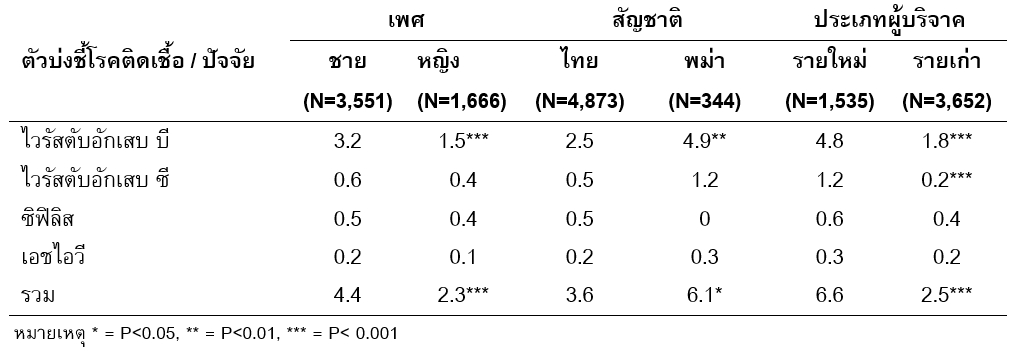Factors associated with detection rate of infectious disease markers in blood donation of Mae Sai Hospital, 2017-2019
Keywords:
Donated blood, Infectious disease markers, Mae Sai hospitalAbstract
Blood is the life-maintaining fluid and can be used as a medical therapy for patients with blood loss or inadequate volume. However, blood transfusion has been and continues to be a possible source of disease transmission. The objective of this study was to determine the prevalence of Infectious Disease Markers in donated blood and also to investigate the relevant factors of Infectious Disease Markers in donated blood. In this study, we collected and analyzed retrospective data of blood donation at Mae Sai hospital, Chiang rai province during 2017 to 2019. The total blood donors of Mae Sai hospital were 5,217 cases consisting of 68.1% male, 31.9% female, 37% age rang 21-30, 29.4% first time donors, and 86.5% donated at the hospital. The most donated blood type was O (43.5%), B (28.4%), A(22.4%) and AB(5.4%) respectively. The infection rates were 3.74% in total; 0.2% HIV, 2.7% Hepatitis B virus, 0.5% Hepatitis C virus and 0.5% syphilis. Male donors had higher levels of prevalence of all 4 markers than female (p<0.001) and the first time donors were found to detect the infectious disease marker higher than repeated blood donors. The results of this study revealed that factors associated with infections in blood donors are gender, nationality, and type of blood donations, indicating that the impact on seeking for the safe donating blood.
References
National Blood Center, Thai Red Cross Society. Guideline on Hemovigilance 1st edition. Bangkok: Udomsuksa; 2015.
National Blood Center,Thai Red Cross Society, Ministry of Public Health. National Blood Policy. Nonthaburi, AgriculturalCredit Cooperatives of Thailand Publishers; 2010.
Wongkham S. Infection rate of HIV virus Hepatitis B Virus Hepatitis C virus and Syphilis in blood donation of Hua Hin Hospital. ChiangRai Medical Journal. 2560; 9(2):105-113.
Ingkananth S,Chanachaisuwan P. Prevalence of infections among blood donors at Police General Hospital. J Hemato lTransfus Med 2015; 25(2):107-114.
Sawdang K., UrwijitaroonY.Prevalence of HIV, HBV, HCV and syphilis infections among blood donors: surveillance for improvement of blood donor recruitment. J HematolTransfus Med 2012; 22(2):83-91.
Jaddee A, Prevalene of HIV, hepatitis B, hepatitis C and syphilis infections among blood donors. Medical Journal of Srisaket Surin Buriram Hospitals 2014; 28(3):197-206.
Pongpun S, Poolkesorn S, Kesudom W, Plipat T. Trend of HIV prevalence in Thailand 2007. WESR 2009; 32: 533-543.
Watanabe KK, Williams AE, Schreiber GB, Ownby HE. Infectious disease markers in young blood donors. Transfusion 2000: 40: 954-960.
Soloslikit W, Sripanithan R, Vienghok P. The effectiveness of counseling for reducing repeated donation among hepatitis infected blood donors in Phrae Hospital. Thai J Hemat Trans Med 2010; 20:11-17.
Poovorawan Yet al., Hepatitis in Migrant Workers in Thailand. The Journal of the Royal Institute of Thailand 2012;1:149-160.
RatchaneewanManeemaroj et al., Serum Ferritin Levels among Blood Donors Who Failed the Initial Screenfor Anemia by Copper Sulfate Method. Naresuan University Journal 2011; Special Issue; 47-52.
Celetano DD, Nelson K, Lyles C, Beyner C, et al. Decreasing incidence of HIV and sexually transmitted disease in young Thai men: evidence for Success of HIV/AIDS control and prevention program. AIDS 1998; 12: 29-36.
Saengdidtha B, Rangsin R. Roles of the Royal Thai Army Medical Department in supporting the country to fight against HIV/AIDS: 18 years of experience and success. J Med Assoc Thai 2005; 88 (Suppl3): S378-387.
Soloslikit W, Sripanithan R, Vienghok P. The Effectiveness of Counseling for Reducing Repeated Donation Among Hepatitis Infected Blood Donors in Phrae Hospital. J Hematol Transfus Med 2010; 20:11-17.

Downloads
Published
How to Cite
Issue
Section
License
Copyright (c) 2022 Naresuan Phayao Journal

This work is licensed under a Creative Commons Attribution-NonCommercial-NoDerivatives 4.0 International License.
ผู้นิพนธ์ต้องรับผิดชอบข้อความในบทนิพนธ์ของตน มหาวิทยาลัยพะเยาไม่จำเป็นต้องเห็นด้วยกับบทความที่ตีพิมพ์เสมอไป ผู้สนใจสามารถคัดลอก และนำไปใช้ได้ แต่จะต้องขออนุมัติเจ้าของ และได้รับการอนุมัติเป็นลายลักษณ์อักษรก่อน พร้อมกับมีการอ้างอิงและกล่าวคำขอบคุณให้ถูกต้องด้วย
The authors are themselves responsible for their contents. Signed articles may not always reflect the opinion of University of Phayao. The articles can be reproduced and reprinted, provided that permission is given by the authors and acknowledgement must be given.







